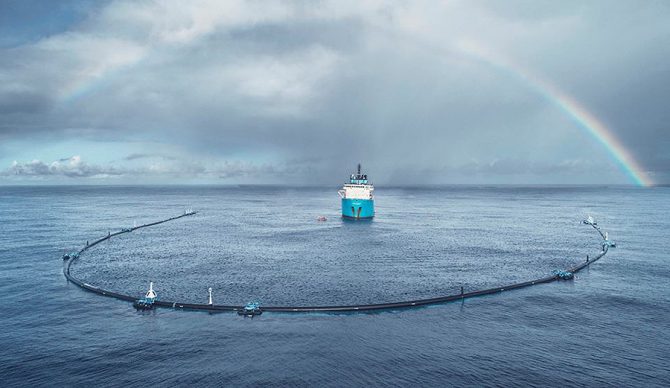
The Ocean Cleanup was brought back to port after part of its system broke. Photo: Ocean Cleanup
It took a full year of testing and development, but on Wednesday, the Ocean Cleanup announced its System001/B is now successfully capturing and collecting plastic debris, which means it can continue on the organization’s original mission of cleaning the Great Pacific Garbage Patch.
If you’ll remember, just before the end of 2018, the Ocean Cleanup’s System 001 broke down, with an end section of the array breaking off. Not only was the original U-shaped design not able to collect as much plastic as intended, it was now releasing a fair amount of debris back into the ocean as well. The system they called “Wilson” was then brought back to port in Hawaii and the Ocean Cleanup team began testing and redesigning their entire system.
System 001/B was launched from Vancouver in June to test the organization’s second design system and after a few months of testing out their new iteration on the original concept, they seemed to up the Ocean Cleanup’s game: System 001/B can now clean up microplastics as small as 1mm, they announced. The announcement is actually a pretty big one considering a major critique of Boyan Slat’s concept over the past six years has been that its system would ignore the equally important challenge of cleaning microplastics.
“The aim of System 001/B was to trial modifications, which addressed known complications, primarily aimed at correcting the inconsistent speed difference between the system and the plastic,” they wrote in a statement. “Consistency was achieved by slowing down the system with a parachute sea anchor, allowing for faster-moving plastic debris to float into the system. Once this main challenge was resolved, prominent plastic overtopping was observed – becoming the next technical challenge to solve. Due to the modularity of System 001/B, a modification to increase the size of the cork line was designed and implemented while the system was offshore. With the new cork line, minimal overtopping is now being observed, thus allowing the system to capture and concentrate the plastic.”
How the new parachute-anchored system now collects microplastics as well as holding the larger debris it was always intended to collect wasn’t explained in the organization’s initial announcement, but another press announcement was scheduled for later Wednesday, possibly with more details.

